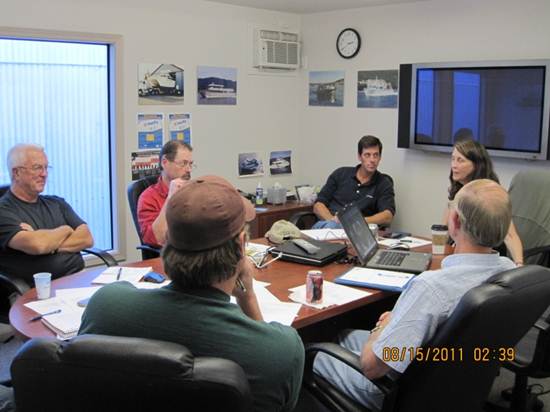The Middlebury Campus has published an interview with me about the R/V David Folger. Check it out!
Tag Archives: research vessel
And the list goes on
It feels as though the past two days have been one long meeting, but we also squeezed in an inspection tour at AAM with Dave Weed, Bauke Houtman of NSF, Ryan of Radar Marine in Bellingham, and of course the whole crew of AAM.

Clockwise from left: Richard Furbush, Dave Weed, Mark Gleason, Pat Manley, Bauke Houtman, and Ryan of Radar Marine.
We discussed the wheelhouse design, integrating the multibeam and ADCP into the construction plan, the construction schedule itself, sea trials, the console for the hydraulics systems and winches, technology and wiring for the smart classroom, integrating the navionics systems with the classroom, arranging the arrival of other Middlebury College equipment, running cables from external equipment into the lab, the wire-out systems and alarms for the instrumented sheave, and the list goes on.
MRI announced; we leave for AAM
The MRI grant has been announced on the College website.
Tom, Richard, and I are off to Bellingham to meet our NSF Program Officer for a major meeting at AAM. Never a dull moment!
MRI grant awarded!
We’ve just been notified that our MRI proposal will be funded! This new NSF grant will be used to purchase the multibeam sonar and underway ADCP we requested last January. We worked very carefully with AAM and all of the equipment vendors to ensure that every expense related to purchasing, installing, and verifying this new equipment on the vessel could be provided through the MRI grant. No vessel contingency funds will be needed.
We are elated. This vessel will be capable of so much — the possibilities are really thrilling!
A new berth for the Baldwin
We’ve been looking for a good home for the R/V Baldwin, the College’s current research vessel, and I’m delighted to report that the Lake Champlain Maritime Museum has responded with a letter of interest. The LCMM is a non-profit museum on Lake Champlain, 20 miles from Middlebury, that runs numerous educational programs on the lake, including “field” trips and a summer program for kids. Their research arm, the Maritime Research Institute, focuses on archaeology and conservation and hosts an underwater field school for budding nautical archeologists. They have also constructed a small fleet of full-sized working replicas of historic vessels, used for education (but mostly while docked). We think the Baldwin will feel right at home there!
The R/V David Folger
Middlebury College’s Board of Trustees has officially adopted the R/V David Folger as the name for our research vessel. It’s named after the Geology professor who started the College’s Lake Studies program back in the early 1970s. His influence in research on Lake Champlain, already important and durable, will continue through our use of this facility named for him.
Daily conversations with AAM and Dave Weed continue, and things are moving along according to the revised schedule. Dave has visited AAM several times in the past two months. We’re in the final stages of completing the smart-lab technology design and integrating it with the wheelhouse navigation systems.
A logo that reflects the lake
In addition to their names and the official identifying information that all boats must display on the stern, most research vessels also have logos. Here’s a first look at the logo for the new research vessel:
We asked for a logo that highlights Lake Champlain’s most characteristic features, and College Communications has come up with a great design. It’s a view over the water to the west, with the sun going down behind the Adirondacks, which are reflected in the lake.
Our students will tell you, though, that the lake is rarely this calm!
USCG T-boat inspection after all!
After many phone calls and emails back and forth, we’ve straightened out the confusion about Coast Guard inspection. The USCG has agreed to inspect the vessel to certify that it meets T-boat safety standards. The inspection will be performed by the Seattle Branch. The Officer in Charge of Marine Inspection there will review the drawings first, select some for further review, and then pass them on to the Marine Safety Center in Washington, DC.
To say we are relieved is an understatement. Without this inspection, the College would not have been able to use its new research vessel!
Contingencies
The updated design and construction specifications book has been completed and approved by the College. I’ve sent a spreadsheet to our contact at NSF, which defines all the change orders and associated costs and explains why they are important, with a request to tap our grant’s contingency funds to cover these changes. (NSF required contingency set-aside, a standard part of construction planning, as a condition of our award; we’re allowed to use it only once they approve our request.)
USCG declines
We received word today that the Coast Guard will not inspect the new research vessel. Clearly there’s some misunderstanding somewhere! Without USCG inspection, the vessel can’t be used the way we need to use it. We’ll appeal this decision. Stay tuned…

